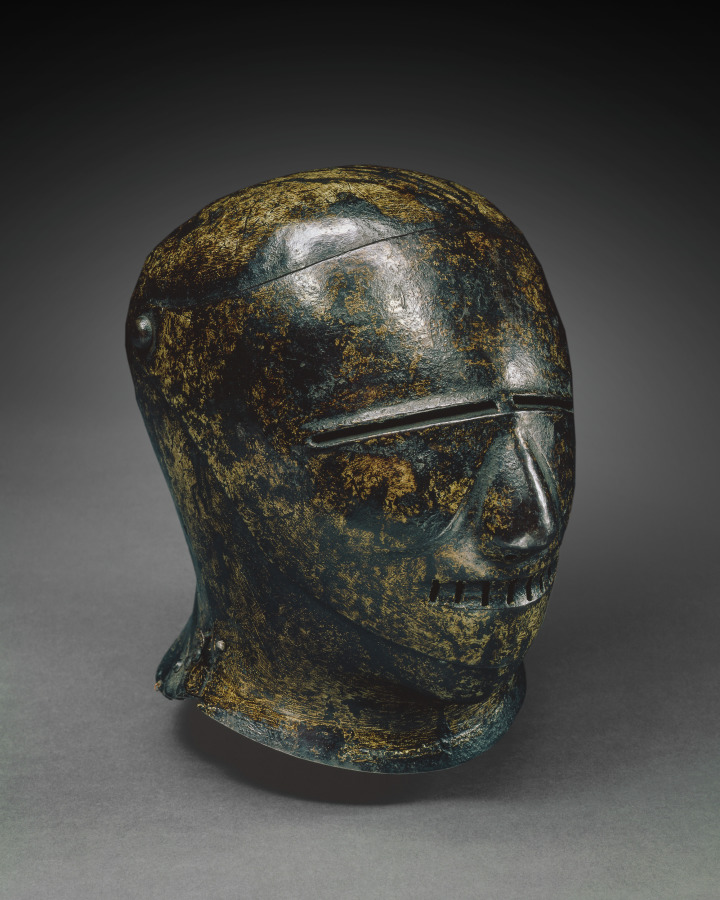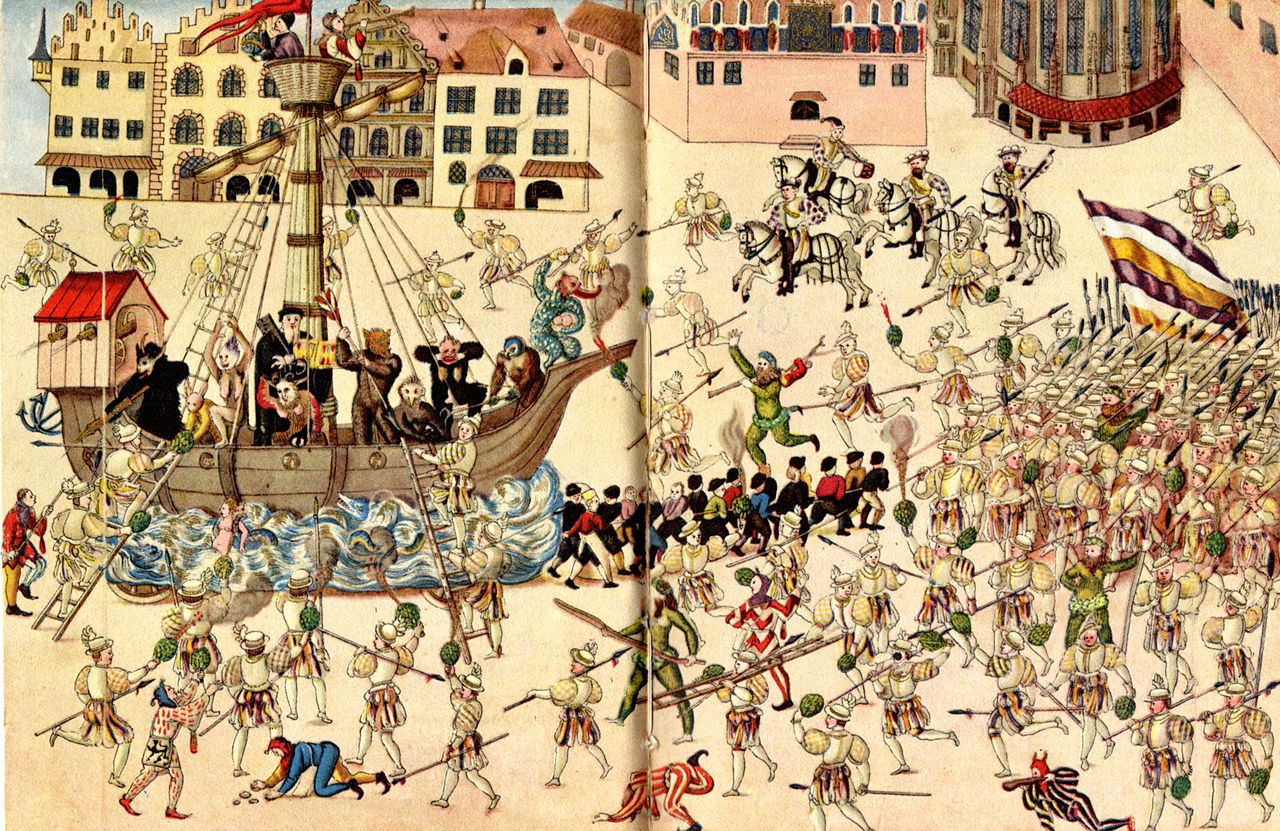Armour for fun
What you are looking at is a helmet a little over 500 years old. In most respects it is another late medieval sallet with a visor. But why was it painted to look almost monstrous?
 This object, which can be found at the Cleveland Museum of Art, is one of a few surviving pieces of armour known as Schembart visors. They would be used at tournaments held in the German city of Nuremberg, during the Schembartlaufen (Schembart Festival). The festival dates back to at least the year 1449 and was said to originate to a revolt that broke out within the city in 1438. The butchers of the city did not join in on the unrest, and as a reward for their support, Emperor Charles IV and the city council gave them the right to hold a festival on every Shrove Tuesday, which in the Christian calendar is the final day before the start of Lent.
Celebrations before Lent is common in the modern world - for example, Mardi Gras in New Orleans - and they could also be found in the medieval world. The events at Nuremberg featured parades, music, fireworks, and lots of revelry. The festival got its name ‘Schembart’ from the German words for 'mask beard' - as many people who attended wore bearded masks made of wood.
We know much about this festival as dozens of manuscripts have survived that detail and depict its events - one can see many examples of the interesting costumes and activities that took place in Nuremberg.
This object, which can be found at the Cleveland Museum of Art, is one of a few surviving pieces of armour known as Schembart visors. They would be used at tournaments held in the German city of Nuremberg, during the Schembartlaufen (Schembart Festival). The festival dates back to at least the year 1449 and was said to originate to a revolt that broke out within the city in 1438. The butchers of the city did not join in on the unrest, and as a reward for their support, Emperor Charles IV and the city council gave them the right to hold a festival on every Shrove Tuesday, which in the Christian calendar is the final day before the start of Lent.
Celebrations before Lent is common in the modern world - for example, Mardi Gras in New Orleans - and they could also be found in the medieval world. The events at Nuremberg featured parades, music, fireworks, and lots of revelry. The festival got its name ‘Schembart’ from the German words for 'mask beard' - as many people who attended wore bearded masks made of wood.
We know much about this festival as dozens of manuscripts have survived that detail and depict its events - one can see many examples of the interesting costumes and activities that took place in Nuremberg.
 As jousting and tournaments were a key part of this festival, the young men who participated would also wear elaborate or painted helmets. You can see more examples here.
Alas, all good things come to an end, and in 1539 the Schembartlaufen was stopped by the Nuremberg Town Council. To learn more, check out the article "Fireworks and Fish Baskets: The Schembart Festival in Nuremberg," by Marcia Reed, Getty Research Journal No. 4 (2012).
As jousting and tournaments were a key part of this festival, the young men who participated would also wear elaborate or painted helmets. You can see more examples here.
Alas, all good things come to an end, and in 1539 the Schembartlaufen was stopped by the Nuremberg Town Council. To learn more, check out the article "Fireworks and Fish Baskets: The Schembart Festival in Nuremberg," by Marcia Reed, Getty Research Journal No. 4 (2012).
 This object, which can be found at the Cleveland Museum of Art, is one of a few surviving pieces of armour known as Schembart visors. They would be used at tournaments held in the German city of Nuremberg, during the Schembartlaufen (Schembart Festival). The festival dates back to at least the year 1449 and was said to originate to a revolt that broke out within the city in 1438. The butchers of the city did not join in on the unrest, and as a reward for their support, Emperor Charles IV and the city council gave them the right to hold a festival on every Shrove Tuesday, which in the Christian calendar is the final day before the start of Lent.
Celebrations before Lent is common in the modern world - for example, Mardi Gras in New Orleans - and they could also be found in the medieval world. The events at Nuremberg featured parades, music, fireworks, and lots of revelry. The festival got its name ‘Schembart’ from the German words for 'mask beard' - as many people who attended wore bearded masks made of wood.
We know much about this festival as dozens of manuscripts have survived that detail and depict its events - one can see many examples of the interesting costumes and activities that took place in Nuremberg.
This object, which can be found at the Cleveland Museum of Art, is one of a few surviving pieces of armour known as Schembart visors. They would be used at tournaments held in the German city of Nuremberg, during the Schembartlaufen (Schembart Festival). The festival dates back to at least the year 1449 and was said to originate to a revolt that broke out within the city in 1438. The butchers of the city did not join in on the unrest, and as a reward for their support, Emperor Charles IV and the city council gave them the right to hold a festival on every Shrove Tuesday, which in the Christian calendar is the final day before the start of Lent.
Celebrations before Lent is common in the modern world - for example, Mardi Gras in New Orleans - and they could also be found in the medieval world. The events at Nuremberg featured parades, music, fireworks, and lots of revelry. The festival got its name ‘Schembart’ from the German words for 'mask beard' - as many people who attended wore bearded masks made of wood.
We know much about this festival as dozens of manuscripts have survived that detail and depict its events - one can see many examples of the interesting costumes and activities that took place in Nuremberg.
 As jousting and tournaments were a key part of this festival, the young men who participated would also wear elaborate or painted helmets. You can see more examples here.
Alas, all good things come to an end, and in 1539 the Schembartlaufen was stopped by the Nuremberg Town Council. To learn more, check out the article "Fireworks and Fish Baskets: The Schembart Festival in Nuremberg," by Marcia Reed, Getty Research Journal No. 4 (2012).
As jousting and tournaments were a key part of this festival, the young men who participated would also wear elaborate or painted helmets. You can see more examples here.
Alas, all good things come to an end, and in 1539 the Schembartlaufen was stopped by the Nuremberg Town Council. To learn more, check out the article "Fireworks and Fish Baskets: The Schembart Festival in Nuremberg," by Marcia Reed, Getty Research Journal No. 4 (2012).